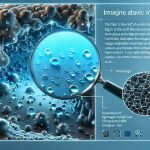Are you curious about the latest advancements in fabric manufacturing? Look no further!
In this article, we will explore the four best innovations that have revolutionized the industry.
Discover sustainable dyeing methods that prioritize environmental conservation.
Explore the world of 3D-printed fabrics, bringing endless possibilities to fashion design.
Uncover the wonders of smart textiles and wearable technology that seamlessly integrate fashion and functionality.
Finally, delve into the realm of nanotechnology, where fabrics are infused with incredible properties.
Get ready to be amazed!
Table of Contents
Sustainable Dyeing Methods
In this section, we’ll explore the use of eco-friendly dyeing techniques that are revolutionizing fabric manufacturing. With increasing concerns about environmental sustainability, the textile industry has been actively seeking natural dye alternatives and developing innovative methods to reduce the negative impact of traditional dyeing processes.
One of the key advancements in eco-friendly dyeing techniques is the use of plant-based dyes. Instead of relying on synthetic dyes that contain harmful chemicals, natural dyes derived from plants and botanical sources are being utilized. These natural dye alternatives not only minimize the release of toxic substances into the environment but also offer a wide range of vibrant colors.
Another promising development is the adoption of waterless dyeing methods. Traditional dyeing processes require large amounts of water, which leads to the pollution of water bodies due to the release of chemicals. Waterless dyeing techniques, on the other hand, eliminate the need for excessive water usage by using innovative technologies such as air dyeing or foam dyeing. These methods not only conserve water but also reduce energy consumption and waste generation.
3d-Printed Fabrics
By incorporating 3D-printed fabrics, you can further enhance the eco-friendly and sustainable practices in fabric manufacturing. 3D printed fashion is a revolutionary concept that’s transforming the way we produce and design clothing. With the advent of digital textile printing, it’s now possible to create intricate and complex patterns directly onto fabric, eliminating the need for traditional manufacturing processes such as cutting and sewing. This not only reduces waste but also saves time and energy.
Digital textile printing allows for greater customization and experimentation in fashion design. Designers can easily manipulate digital files to create unique patterns and textures, resulting in one-of-a-kind garments. Additionally, 3D printing enables the production of complex structures and shapes that would be difficult or impossible to achieve using traditional methods. This opens up a world of possibilities for innovative and avant-garde fashion designs.
In terms of sustainability, 3D-printed fabrics offer several advantages. The process uses less water and energy compared to traditional manufacturing techniques, reducing the carbon footprint of the fashion industry. Additionally, the ability to print garments on demand reduces overproduction and waste. With digital textile printing, it’s also possible to use eco-friendly and biodegradable materials, further minimizing the environmental impact.
Smart Textiles and Wearable Technology
To explore the exciting world of smart textiles and wearable technology, you can discover a range of innovative fabric manufacturing techniques. One of the key advancements in this field is the development of sensing fabrics, also known as e-textiles. These fabrics are made by integrating electronic components, such as sensors and conductive materials, directly into the fabric itself.
Sensing fabrics have the ability to detect and respond to various stimuli, making them ideal for applications in healthcare, sports, and fashion. For example, in healthcare, sensing fabrics can be used to monitor vital signs, such as heart rate and body temperature, allowing for remote patient monitoring and early detection of health issues. In sports, these fabrics can provide real-time feedback on performance metrics, helping athletes optimize their training and prevent injuries.
The integration of electronics into textiles has also led to the development of wearable technology. These are garments and accessories that incorporate electronic components, such as smartwatches and fitness trackers. Wearable technology has become increasingly popular in recent years, as it allows for seamless integration of technology into our daily lives.
Nanotechnology in Fabric Production
Now let’s delve into the realm of nanotechnology and its impact on fabric production. Nanotechnology has revolutionized the textile industry, enabling the development of fabrics with remarkable properties.
Here are three ways nanotechnology is transforming fabric manufacturing:
-
Superhydrophobic coatings: Nanotechnology has made it possible to create fabrics that are highly water-repellent. Superhydrophobic coatings, composed of nanoparticles, can be applied to fabrics to create a barrier that repels water droplets. This means that liquids simply roll off the fabric, preventing stains and keeping the wearer dry. Whether it’s rain, spills, or sweat, fabrics treated with superhydrophobic coatings offer exceptional protection.
-
Self-cleaning fabrics: Nanotechnology has also paved the way for self-cleaning fabrics. By integrating nanoparticles with photocatalytic properties into the fabric, it becomes capable of breaking down organic substances when exposed to light. This process, known as photocatalysis, can remove dirt, bacteria, and odors from the fabric. As a result, garments made from self-cleaning fabrics require less frequent washing, reducing water consumption and extending the lifespan of the fabric.
-
Enhanced durability: Nanotechnology has improved the durability of fabrics by reinforcing their structure at the molecular level. Nanoparticles can be added to fabric fibers during the manufacturing process, enhancing their strength and resistance to wear and tear. This means that fabrics treated with nanotechnology can withstand repeated use and washing without losing their properties or integrity.
Frequently Asked Questions
What Are the Environmental Benefits of Sustainable Dyeing Methods?
Sustainable dyeing methods have environmental benefits. They reduce the environmental impact of fabric manufacturing by using eco-friendly dyes and processes. These innovations contribute to the growth of sustainable fashion.
How Do 3d-Printed Fabrics Compare to Traditionally Manufactured Fabrics in Terms of Durability?
3D printed fabrics have been compared to traditional fabrics in terms of durability. Innovative techniques in fabric durability have led to advancements in strength and longevity, making 3D printed fabrics a viable option.
Can Smart Textiles and Wearable Technology Be Easily Integrated Into Everyday Clothing?
Smart textiles and wearable technology can be easily integrated into everyday clothing, but there are some integration challenges to consider. Consumer acceptance also plays a crucial role in determining the success of these innovations.
What Are Some Potential Applications of Nanotechnology in Fabric Production?
Nanotechnology offers potential applications in fabric production. It can improve fabric durability, stain resistance, and UV protection. The benefits of nanotechnology include enhanced performance and functionality, making fabrics more versatile and advanced.
Are There Any Limitations or Challenges in Implementing These Fabric Manufacturing Techniques on a Large Scale?
Implementing fabric manufacturing techniques on a large scale can present limitations and challenges. These can include the need for substantial infrastructure, high costs, and potential environmental impacts.
- What Is Gore-Tex Active? A Guide to the Lightweight Fabric - July 1, 2025
- What Is Gore-Tex Active? A Guide to the Lightweight Fabric - July 1, 2025
- What Is Gore-Tex Active? A Guide to the Lightweight Fabric - July 1, 2025



